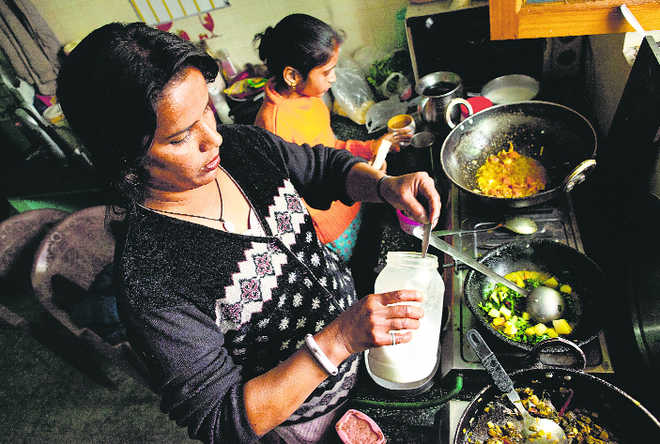
a dash of spice: Most Garhwali and Kumaoni kitchens are stocked with gur and bhang chutneys
Jaskiran Chopra
The mention of Uttarakhand conjures up in the mind a picturesque Himalayan landscape with its majestic snow-capped peaks, gushing rivers, lush green valleys and wooded slopes. It also evokes images of the simplicity of the hill folk and reminds one of the unique tastes of wholesome dishes — hardy fare that gives warmth in winter and energy the year around.
Tourists visiting Uttarakhand are always interested in tasting local cuisine. In fact, in Dehradun, we now see many restaurants serving local food. Some visitors prefer to have a traditional meal at the home of a friend or an acquaintance.
THE FIRST MEAL
In any Garhwali home, the day usually begins, especially in winters, with mandua ki rotis served hot with either ghee and gur or with lahsun or til ki chutney. Paranthas stuffed with boiled toor or gahat (kulath or horse gram) daals are another favourite Garhwali breakfast.
THE DELICACIES
Chainsoo, a pahari delicacy, is made from black urad daal, roasted and then ground into a coarse powder, which is cooked in oil in the form of a curry. Chainsoo tastes great with rice. Bhatwani, which is popular in Kumaon, substitutes urad with bhaat (a variety of soyabean). Phaanu, another delicacy, is also made of daals like chainsoo, but in this case, the daals are soaked in water for about four to six hours before use. And then there is thechwani made either with round-rooted pahari radish (called mula) or with potatoes. The radish or potatoes are not cut, but crushed to pieces. A gravy is prepared using cumin seeds, chopped onions, turmeric powder and asafoetida, to which the fried vegetable is added with salt.
THE GREENS
There are a rich variety of green leafy vegetables like pahari palak (made into a thick green curry called kafuli). Leafy greens are usually cooked simply by stir frying the chopped leaves in smoking mustard oil. The preparations are called bhujji and are usually served with rice.
THE CHUTNEYS
Rather unusual chutneys are found in Garhwali and Kumaoni kitchens. The most popular among the Garhwalis, especially in winters, is til chutney made from white sesame seeds. The seeds are dry roasted in a pan and then ground with coriander leaves, garlic cloves and green chillies after which lemon juice or curd is added to make a paste. Salt is then added. For the Kumaonis, it is bhang chutney that substitutes sesame with bhang (marijuana) seeds. Unlike the leaves of bhang, its seeds are not an intoxicant.
NON-VEGETARIAN FARE
Mutton is greatly relished in pahari households. Bhuttua and Kachmauli are regarded as delicacies. Bhuttua refers to the cooked intestines of a goat while for Kachmauli, a whole animal (usually a goat) is smoked for hours over a fire of green leaves and tender twigs.
Dessert section
Baal mithhai and singori are most famous sweets of Uttarakhand. Baal mithai is made by cooking khoya with cane sugar, until it becomes dark brown in colour. When cool, it is cut into cubes, which are garnished with white sugar balls that look like beads. Singori is another preparation of flavoured khoya, which is wrapped in oak leaves.
Festive special
Many of the recipes are related to festivals and special occasions. These include kesar halwa, which is cooked on Basant Panchami, meethha bhaat (sweet rice) and urad dal ki pakori (right) that one can savour on Makar Sankranti. These taste quite like the South Indian vadas, but are also different in that they have white sesame seeds, haldi and garam masala. Rot and arsa (below), which can be kept for weeks, are also made on auspicious occasions such as weddings.
The staples
Rice, pulses, finger millet, jaggery, mustard oil and potatoes form the broad base of almost all the important dishes. Rice, kulath daal and toor daal are the main features of a Garhwali diet and, besides the delicious taste, are full of nutrition and medicinal properties. Toor-bhaat is cooked in all pahari homes almost every day during the winter months.



























